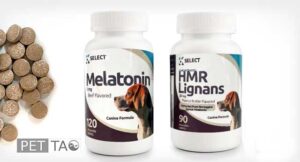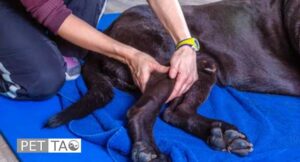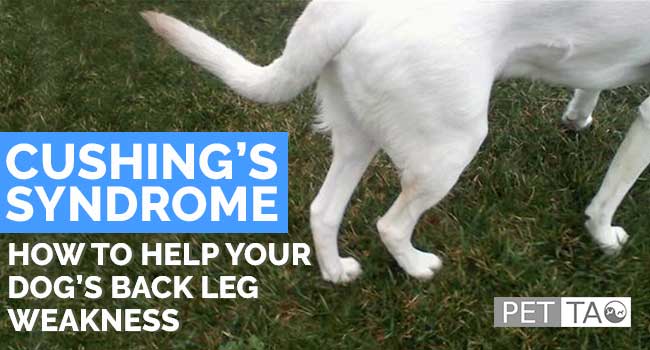What Causes Problems in a Cushing’s Syndrome Dog’s Back Legs?
Cushing’s disease, also known as hyperadrenocorticism, is a condition that affects dogs and is characterized by an overproduction of cortisol, a hormone produced by the adrenal glands.
While Cushing’s disease primarily affects the endocrine system, it can indirectly impact various body parts, including the muscles and bones.
In some cases, Cushing’s disease can lead to muscle weakness and wasting, which can affect a dog’s back legs.
The weakened muscles may decrease the dog’s ability to support its weight, causing difficulties with mobility and coordination.
Cushing’s disease can also lead to secondary conditions such as diabetes, which can further contribute to muscle weakness and affect a dog’s ability to use its back legs properly.
It’s important to note that the symptoms and severity of Cushing’s disease can vary between individual dogs.
Some dogs may not exhibit noticeable problems with their back legs, while others may experience more significant issues.
And, unfortunately, there is currently no cure for Cushing’s disease. However, you can manage the symptoms and give your dog a healthy, happy life.
What helps a Cushing’s syndrome dog’s back leg problems?
If your dog with Cushing’s disease is experiencing issues with their back legs, there are several things you can do to help improve their comfort and mobility.
Below are some suggestions.
Consult With a TCVM-Trained Veterinarian
It’s crucial to seek professional guidance from a veterinarian who can evaluate your dog’s specific condition and provide tailored advice.
However, you’ll benefit the most if you seek guidance from a TCVM-trained vet.
TCVM stands for Traditional Chinese Veterinary Medicine. Vets trained in TCVM work with herbs and other Eastern modalities highly beneficial to dogs suffering from Cushing’s disease.
TCVM-trained vets can help you with all of the regular medical details involved with Cushing’s.
In addition, you’ll get extra options and advice.
TCVM-trained vets also work with Eastern herbal formulas, which can be used to help your Cushing’s syndrome dog’s back legs.
There are several formulas to help dogs regain leg strength. A good example is the herbal formula Hindquarter Weakness.
However, several different herbal formulas can help, depending on the dog’s particular needs. So, you need the assistance of a TCVM-trained veterinarian to find the right formula for your dog.
Acupuncture
TCVM-trained veterinarians also offer acupuncture as a treatment to help a Cushing’s syndrome dog’s back legs.
Acupuncture is an effective tool to help manage symptoms such as muscle weakness or discomfort.
Acupuncture helps stimulate blood flow, release endorphins, and promote muscle relaxation, positively impacting your dog’s mobility.
It is an excellent supportive therapy to alleviate symptoms and improve your dog’s quality of life.
Medication and Supplement Management

Effective management of Cushing’s disease can help alleviate symptoms affecting your dog’s back legs.
Our founding vets often recommend supplementing with melatonin and lignans to help dogs suffering from Cushing’s Disease.
Often, melatonin and lignans work so well that some dogs don’t need to add in pharmaceuticals. However, other dogs require pharmaceuticals as treatment.
Weight Management
Maintaining a healthy weight is essential to reduce stress on your dog’s joints and muscles.
If your dog is overweight, work with your veterinarian to develop a suitable diet and exercise plan to help them reach and maintain a healthy weight.
Our veterinarians recommend a special Cushing’s disease diet to help dogs with Cushing’s disease feel better.
Maintaining a healthy weight also helps a Cushing’s syndrome dog’s back legs. A lower body weight puts less stress on the legs, making it easier for your dog to move around and exercise.
Physical Therapy and Exercise

For example, our veterinarians often recommend slow uphill walking to help strengthen a dog’s back legs.
Physical therapy techniques like hydrotherapy or gentle massage like Tui-Na can also benefit a Cushing’s syndrome dog’s back legs.
Assistive Devices
Depending on the severity of your dog’s back leg weakness, assistive devices such as ramps, harnesses, or slings can provide support and stability during walks or when going up and down stairs.
Using an assistive device can help relieve the pressure on your Cushing’s syndrome dog’s back legs and allow you to help your dog get around.
Environmental Modifications
Adjust your home environment to minimize potential obstacles and hazards for your dog.
Provide non-slip surfaces and clear pathways, and consider using carpets or rugs to improve traction.
Regular Check-Ups
Schedule regular follow-up visits with your veterinarian to monitor your dog’s condition, adjust treatment plans if needed, and ensure their overall health is managed effectively.
Remember, every dog is unique, and the appropriate interventions may vary. Consulting with a veterinarian familiar with your dog’s condition will provide you with the most accurate and personalized advice.
More Help for Dogs Suffering from Cushing’s Disease
If your dog suffers from Cushing’s disease, we have several resources to help.
TCVM Pet Supply’s article, Inside Scoop: TCVM Veterinarians Share Holistic Cushing’s Disease Protocol, explains in detail how you can help your dog at home.
Also, please check out our free ebook download, Solutions for Dogs with Cushing’s Disease: How to Help Your Best Friend Feel Better.
Do You Need Extra Help with Your Cushing’s Syndrome Dog’s Back Legs?
Our founding veterinarians, Dr. Marc Smith and Dr. Casey Damron offer Holistic and TCVM (Traditional Chinese Veterinary Medicine) Telemedicine Consultations.
If you get a TCVM telemedicine consultation with one of our veterinarians, you’ll get personalized recommendations specific to your pet, including:
- Food Therapy Recommendations
- TCVM Herb Recommendations & Veterinary Authorization
- Supplement Recommendations
- Alternative Medicine Recommendations
- Answers to Your Questions
You can learn more about our founding veterinarians and their expertise and/or schedule by visiting their websites:
- Marc Smith, DVM, MS – Natchez Trace Veterinary Services
- Casey Damron, DVM, CVA – White Oak Animal Hospital








